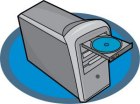Optical computing means performing computations, operations, storage and transmission of data using light instead of electricity. Instead of silicon chips optical computer uses organic polymers like phthalocyanine and polydiacetylene.Optical technology promises massive upgrades in the efficiency and speed of computers, as well as significant shrinkage in their size and cost. An optical desktop computer is capable of processing data up to 1, 00,000 times faster than current models.
Advantages
Optical computing is cheaper or more powerful than conventional computers.
Within one data path several data sets can be transmitted parallel at the same time using different wavelengths or polarizations. Data paths are able to cross each other without interference.
The superior velocity of light allows extreme processing speeds.
Optical computers are said to run much faster than electronic
computers
Disadvantages
The development of its price is still expensive
Optical components can be build small and compact but not really miniaturized
Optical computers may use a different architecture. So these programs cannot use the full optical computers
High-tech factory costs several millions up to billions of dollars to be built
Difference between Optical computing and conventional computing
Optical computing
Data paths are able to cross each other without interference
Based on two dimensions
High performance
Bottleneck could disappear
Less heat is released
Less noise
Change the shape and layout
The distance of communication does not matter
Long-range communication is possible. the data rate is very high and there is no crosstalk
conventional computing
Crossed data paths are not possible
Based on three dimensions
Performance lesser than optical computing
Bottleneck could appear
Produce heat to a greater or lesser extent
A lot of noise. developed fans to reduce noise
Built as a rectangular box (desktop) or as a laptop
Communication depends on the distance
Longer distances decrease of the practical transfer rate
Features
Wireless Optical Mouse
The ultimate speed is the speed of light.
Massaging your hand by infrared ray
Quick and stable temperature (at 45+/-1) for warming your hand
Safety material for avoiding damaging the component of mouse
High precision option
Plug and play, no-driver required
Scroll without scrollbars
Optical tracking engine
Comfortable shape
low-consumption devicesThe mouse is designed to be used by younger children and features a smaller form factor that allows for an easier grip. It also features a colorful design that will make your child more interested in using a computer.
The mouse itself is rated for up to 1 million clicks.The mouse features an 800 dpi optical tracking interface. Optical tracking is much more precise than a mechanical ball mouse, and is also less prone to mechanical failure.
Past research
Existing silicon technology would represent a potentially less expensive and more feasible way to mass-produce future-generation devices that would use both electrons and photons to process information, rather than just electrons as has been the case in the past.
Less than one year ago, created laser light from electrical current on silicon by placing a layer of the silicon.
Ongoing research
This research builds upon the development of the silicon laser. Computer technology now depends on silicon electronics for data transmission. Researchers have used this platform to demonstrate electrically-pumped lasers emitting 40 billion pulses of light per second. because light can move thousands of times faster through solid materials than electrons and can carry more information at once, while requiring less energy. This is the first ever achievement of such a rate in silicon.
Creating optical components in silicon will lead to optoelectronic devices that can increase the amount and speed of data transmission in computer chips while using existing silicon technology.
Optical chips based on silicon photonic crystals would include their reduced risk of overheating due to lower power needs.
Source:
Sangeetha Priya.K lecturer,
Dept of MCA, Tamilnadu College of Engineering, Karumathampatti, Coimbatore
Tuesday, June 9, 2009
Subscribe to:
Post Comments (Atom)





No comments:
Post a Comment